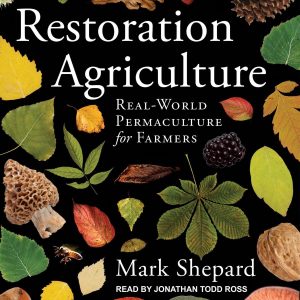 Like many people who grew up in suburbia, my direct experience with innovative farming techniques has been limited to grade-school field trips and a history class explanation of the Dust Bowl. However, as the condition of the world’s soil worsens by the day, everyone must begin fighting for sustainable alternatives. Author and Engineer Mark Shepard introduces one such solution in his book Restoration Agriculture: Real World Permaculture for Farmers.
Like many people who grew up in suburbia, my direct experience with innovative farming techniques has been limited to grade-school field trips and a history class explanation of the Dust Bowl. However, as the condition of the world’s soil worsens by the day, everyone must begin fighting for sustainable alternatives. Author and Engineer Mark Shepard introduces one such solution in his book Restoration Agriculture: Real World Permaculture for Farmers.
Permaculture, a method of farming that stands opposed to the dominant practice of annual single-crop farming, follows the growth habits of pre-industrial eras, incorporating biodiversity, crop yields, and other sustainable practices. Encouraging farmers and practitioners to take the long view when it comes to the health of their farms and surrounding ecosystems, this book is more of a general overview than a strict “how-to” guide. Ruminating at length about the “get big or get out” style of farming that followed the trade machinations of OPEC in the 1970’s, Shepard excels in educating readers about the history behind modern agriculture. Yet, since practical information is sparse, one does not learn how to begin building multi-layered structures of permaculture perfection.
Inspired by natural patterns observed in earth’s ecosystems over the centuries, the modern idea of a permaculture (a portmanteau of “permanent” and “agriculture”) was introduced in the 1970’s by Bill Mollison and David Holmgren as a model for a completely sustainable human habitat. By curating relationships between livestock, trees, bushes, and crops, permaculture is a very efficient method of growing food. Yet, because permacultures require techniques that are particular to their climates, broader adoption might be difficult and incompatible with large-scale collective action. This is likely the reason why Shepard is sparse with details of the practice. Since each attempt to introduce permaculture requires a laundry list of unique considerations, chapters on how to account for monsoon winds will not generate much interest when marketing towards a western audience. Even though the details on how to mimic the patterns and relationships found in nature are full of minutiae, Restoration Agriculture would have benefitted from a deeper discussion of how the ethics behind this farming style can percolate into broader social systems. Principles such as applying self-regulation, giving feedback, using and valuing diversity, and employing pattern-oriented design are relevant to everyone fighting for social and environmental change.
Shepard employed these permaculture practices on his New Forest Farm in Viola, WI. Noticing that the backyard style of farming was not enough to sustain a healthy diet (staples like rice, corn, and bread still need to be purchased from the store), Shepard sought to create a culture that satisfies all dietary needs in one grove. Swapping out corn for staples like chestnuts and hazelnuts, he created an inspiring perennial polyculture food system that provides an alternative to industrial agriculture. More information about Shepard’s practices is available on this corresponding website, which offers consultations and useful agricultural knowledge.
There are a few organizations that specialize in permaculture in and around the Chicago area. The Resiliency Institute seeks to transform the suburbs using permaculture design and principles. In Kenwood Park, there is a permaculture garden that serves as a pollinator garden and grows edible plants. Check out each website to learn more about how permaculture can become a staple of Chicago.
Restoration Agriculture: Real World Permaculture for Farmers is a great primer on what permaculture is capable of and how it emerged from the past to fuel our future. For more information on how to access the book itself, follow the link here to learn more.
—--Jacob Rosen

